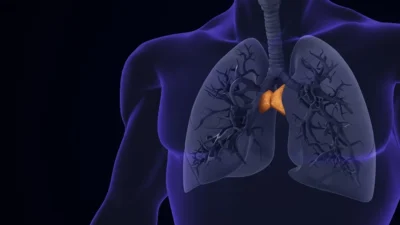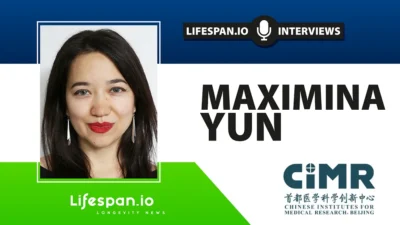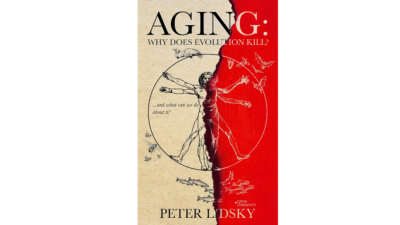The thymus gland is located at the top of the breastbone and is where the majority of T cells are produced by the immune system. One can think of the thymus as being like an army camp where new soldiers are trained and given their weapons to fight invading forces; in this case, the T cells are those soldiers, and the battlefield is your body.
As we age, the thymus begins to shrink, and fewer numbers of T cells are created and trained to fight. This structural decay of the thymus is one of the main reasons why we become increasingly vulnerable to infectious diseases, such as influenza and pneumonia. The other reason is immune cells becoming senescent.
There are a number of possible solutions to this problem. Firstly, engineering new healthy and youthful thymic tissue might help to restore the immune system, and indeed a number of groups are working towards this.
Secondly, some researchers are focused on encouraging the aged thymus to regrow using various approaches, such as stem cell transplants, cellular reprogramming or chemical compounds. Dr. Greg Fahy is involved in researching this second approach, and we had the opportunity to speak to him about this work.
Introducing Dr. Greg Fahy
 Hailing from California, Dr. Fahy holds a Bachelor of Science degree in Biology from the University of California at Irvine and a Ph.D. from the Medical College of Georgia in Augusta. Dr. Fahy used to be the Head of the Tissue Cryopreservation Section of the Transfusion and Cryopreservation Research Program for the U.S. Naval Medical Research Institute in Bethesda, Maryland, where he developed the original concept of ice blocking agents.
Hailing from California, Dr. Fahy holds a Bachelor of Science degree in Biology from the University of California at Irvine and a Ph.D. from the Medical College of Georgia in Augusta. Dr. Fahy used to be the Head of the Tissue Cryopreservation Section of the Transfusion and Cryopreservation Research Program for the U.S. Naval Medical Research Institute in Bethesda, Maryland, where he developed the original concept of ice blocking agents.
Before his time at 21st Century Medicine, where he currently is Vice President and Chief Scientific Officer, Dr. Fahy pioneered the practical use of cryopreservation by vitrification and invented a computer system to apply this technology to organs at the American Red Cross.
With over 30 years of experience in cryobiology, Dr. Fahy is considered a world expert in organ cryopreservation by vitrification[1-3]. He introduced the modern successful approach to vitrification for the cryopreservation process to cryobiology[4-8], and also managed to prove that restoration of organ function after cryopreservation is possible.
Dr. Fahy is also a biogerontologist and is the originator and Editor-in-Chief of The Future of Aging: Pathways to Human Life Extension, a multi-authored book about the future of biogerontology.
For 16 years, Dr. Fahy worked as a Director of the American Aging Association and for 6 years as the editor of AGE News, the organization’s newsletter. He currently serves on the editorial boards of Rejuvenation Research and the Open Geriatric Medicine Journal.
Dr. Fahy kindly agreed to tell us about some of the exciting things he has been working on and, in particular, about the studies he has been conducting on rejuvenating the thymus in humans.
Hi, Greg, thank you for finding the time to talk to our readers about your work. So from around age 20 (or younger) the thymus begins to shrink and loses the ability to produce T cells, why does this happen?
Nobody knows why thymic atrophy, or involution, occurs, but it happens in all vertebrates, starting really at the age of puberty. Some have suggested that it happens to save energy, since the production of properly qualified T cells is very energy intensive and inefficient, and of course, at puberty, the body begins to devote more energy to reproduction, which might require a tradeoff against using energy for immune maintenance.
This could be adaptive since, in nature, humans would not have lived long enough for immune system collapse to set in, even though today, the situation is different. Regardless of the evolutionary reason for it, the most immediate biochemical cause of involution seems to be mostly a drop in thymic FOXN1 expression, although some have pointed to a decline in intra-thymic IL-7 and the negative influence of circulating sex hormones, for example.
Can you please give our readers a few examples of which age-related diseases are promoted by the decline of thymus function.
The job of the immune system is to fight infectious disease and cancer, and a healthy immune system also knows how to do these things without attacking self. With immunological aging or immunosenescence, all three of these functions weaken. T-cell-based immunity begins to collapse in the 60s, and this goes virtually to completion before 80. Coincident with this, we see, for example, more than 90% of seasonal flu deaths and most hospitalizations for the flu in the US taking place in people over 65 years of age, and the response to vaccination becoming poorer as well.
Pneumonia, also, begins to become particularly deadly. In the 20th century, the mean human lifespan was greatly increased in large part by public health measures that radically diminished the death rate from infectious diseases like tuberculosis, polio, smallpox, diphtheria, etc., but you might also say that what also happened was to just postpone death from infectious diseases to after 60-65 years of age, which means that the same basic problem still remains. Perhaps this problem can, finally, be largely conquered by maintaining thymic function.
Twenty years ago, the role of the immune system in controlling cancer was not fully appreciated, but today, it is clear that a key job of the immune system is to attack and eliminate cancerous and precancerous cells. In fact, some of the best cancer therapies ever created are cancer immunotherapies, in which the patient’s own immune cells are harnessed to target and kill cancer cells. So it is probably not a coincidence that in older people, the incidence of cancer skyrockets at the same time T cell immunity fails. The implication is that if thymic and immunological regeneration can be accomplished, perhaps cancer incidence can be kept low throughout life, and on top of this, if cancer does occur, perhaps immunotherapies for cancer will be more effective.
Finally, it is now accepted that the third function of the thymus, which is to prevent the immune system from attacking its host, also declines with age. This allows chronic autoimmune reactions to accumulate with age, and presumably contributes to the age-related chronic inflammation that is observed to occur, which is sometimes called “inflammaging”. This condition has many detrimental effects.
You recently ran a human clinical trial to regrow the thymus gland. Can you please tell us what is the main goal of the project and what is the progress?
The trial was conducted under an FDA-approved IND and with review from multiple scientific and ethics committees. It consisted of a 12-month treatment course for 9 men divided into two cohorts, with the first cohort starting in October of 2015 and the second ending in April of this year. Our goal was to gather preliminary evidence indicating that it is possible to safely regenerate the normal aging human thymus and restore its functions, essentially reversing the process of age-related immunological deterioration.
We chose to work with healthy men in part because this was a small trial, which required a reasonably uniform population, and in part because more information was available for men than for women. We chose an age range of 50 to 65 years because this range extends from several years before to a few years after the threshold age at which the immune system tends to collapse. Success would therefore suggest the possibility of preventing or even reversing the early stages of immune collapse. In future trials, we intend to enroll both women and older men.
The outcome measures included MRI evaluation of thymic density before and after treatment, simple and sophisticated assessment of T cell population distributions, measurements of many serum factors related to immune system function and general health, lymphocyte telomere length distributions and telomerase activity, and biological age based on the Horvath epigenetic clock. Regarding our results, first of all, when you’re working with human beings, safety has to be the top priority, so I’m glad to be able to say that we met or exceeded all of our safety targets.
Regarding thymic imaging results, preliminary analyses indicate that there was a consistent and substantial increase in thymic density, which indicates replacement of thymic fat with more water-rich material, and in previous studies on human immunodeficiency patients, this coincided with improved thymic function. Superficial tests of immune system aging showed improvements in 8 out of 9 men, and we were able to identify a possible correctable reason for the failure of the 9th volunteer. Men of all ages were able to respond positively and to avoid side effects. However, the most definitive endpoints of our study are still being analyzed at four different locations around the world, so we won’t really know the final results of our study for probably another month or two.
Are we going to see a publication anytime soon?
I’m not sure about soon, but certainly, as soon as we can. This will be a complicated paper with lots of authors and lots of data to present, but also with top-tier academic co-authors who can help us go through the scientific review process quickly. In any case, we certainly want to make sure that any novel results are shared with the broader medical and scientific communities.
Our readers are curious, what are other promising approaches to restore thymus function. Why did you choose human growth hormone over using stem cell transplants like the 2015 experiment[9] where they used TECs to regrow a mouse thymus?
We choose methods based on safety, efficacy, and speed. A simplified version of our treatment has been independently proven to work with safety in HIV patients, so there is already extensive human clinical data suggesting that our approach will be effective in people. There is really no alternative approach that has already been tested with success on people, and moving from mice to people is usually costly, uncertain, and very time-consuming.
Take the TEC experiments you mentioned, for example. Only TECs from mouse embryonic day 14.5 to postpartum day 1 engrafted adequately into the thymus of adult mice, and TECs from later ages failed. Parabiosis also failed to regrow the adult thymus. So, how would you apply this to humans? Mouse embryonic day 15 corresponds to the middle of the human third trimester of gestation, so you’re not going to get the needed cells from human fetuses. You might try to create the needed cells from scratch, but nobody knows how to do that yet. Maybe someday, someone will figure this out, and maybe someday, long after that, the FDA will actually approve that treatment, after all of the presently-unknown safety issues have been worked out.
And the same is true of most of the other approaches you may have heard of or thought of yourself, the actual human application is not likely anytime soon. An example of a potentially short-term alternative that frequently comes up is surgical or chemical castration. However, although gonadectomy regrows the thymus on some level, it doesn’t always restore immune function.
Furthermore, testosterone reduces cardiovascular morbidity and mortality in men, ovariectomy shortens lifespan in mice, and transplantation of young ovaries to old mice increases their lifespan, so for both sexes, gonadal ablation may have lifespan-shortening effects, which would partly defeat the goal of thymic regeneration, not to mention the negative effects on quality of life! So this is an example of treatments that might positively modulate thymic activity but have side effects that partly or completely outweigh the benefits or that may take a long time to define. In contrast, our treatment is generally very well tolerated and even has some “positive side effects” that volunteers actually enjoy.
What we see is that we’re losing huge numbers of people to aging every day, so we can’t wait. We need something we can use right now, almost this minute. That’s why we use agents that the FDA already likes, or will easily like. This should greatly simplify and speed the approval process, and maximize the chances of success. We’re on the job, and looking at every possible practical way forward. Stay tuned!
We would like to thank Dr. Fahy for taking the time to speak to us about his exciting work, and we are very excited to hear that there has been positive progress. We look forward to seeing the published results in the future.
Literature
[1] Fahy, G. M., Wowk, B., Wu, J., Phan, J., Rasch, C., Chang, A., & Zendejas, E. (2004). Cryopreservation of organs by vitrification: perspectives and recent advances. Cryobiology, 48(2), 157-178.
[2] Fahy, G. M., Wowk, B., & Wu, J. (2006). Cryopreservation of complex systems: the missing link in the regenerative medicine supply chain. Rejuvenation research, 9(2), 279-291.
[3] Fahy, G. M., Wowk, B., Pagotan, R., Chang, A., Phan, J., Thomson, B., & Phan, L. (2009). Physical and biological aspects of renal vitrification. Organogenesis, 5(3), 167-175.
[4] Fahy, G. M., & Hirsh, A. (1982). Prospects for organ preservation by vitrification. Organ Preservation, Basic and Applied Aspects, MTP Press, Lancaster, 399-404.
[5] Fahy, G. M., MacFarlane, D. R., Angell, C. A., & Meryman, H. T. (1984). Vitrification as an approach to cryopreservation. Cryobiology, 21(4), 407-426.
[6] Rall, W. F., & Fahy, G. M. (1985). Ice-free cryopreservation of mouse embryos at− 196 C by vitrification. Nature, 313(6003), 573-575.
[7] Fahy, G. M. (1986). Vitrification: a new approach to organ cryopreservation. Progress in clinical and biological research, 224, 305.
[8] Mullen, S. F., & Fahy, G. M. (2011). Fundamental aspects of vitrification as a method of reproductive cell, tissue, and organ cryopreservation. Principles & practice of fertility preservation. Cambridge University Press, Cambridge, 145-163.
[9] Kim, M. J., Miller, C. M., Shadrach, J. L., Wagers, A. J., & Serwold, T. (2015). Young, proliferative thymic epithelial cells engraft and function in aging thymuses. The Journal of Immunology, 194(10), 4784-4795.









